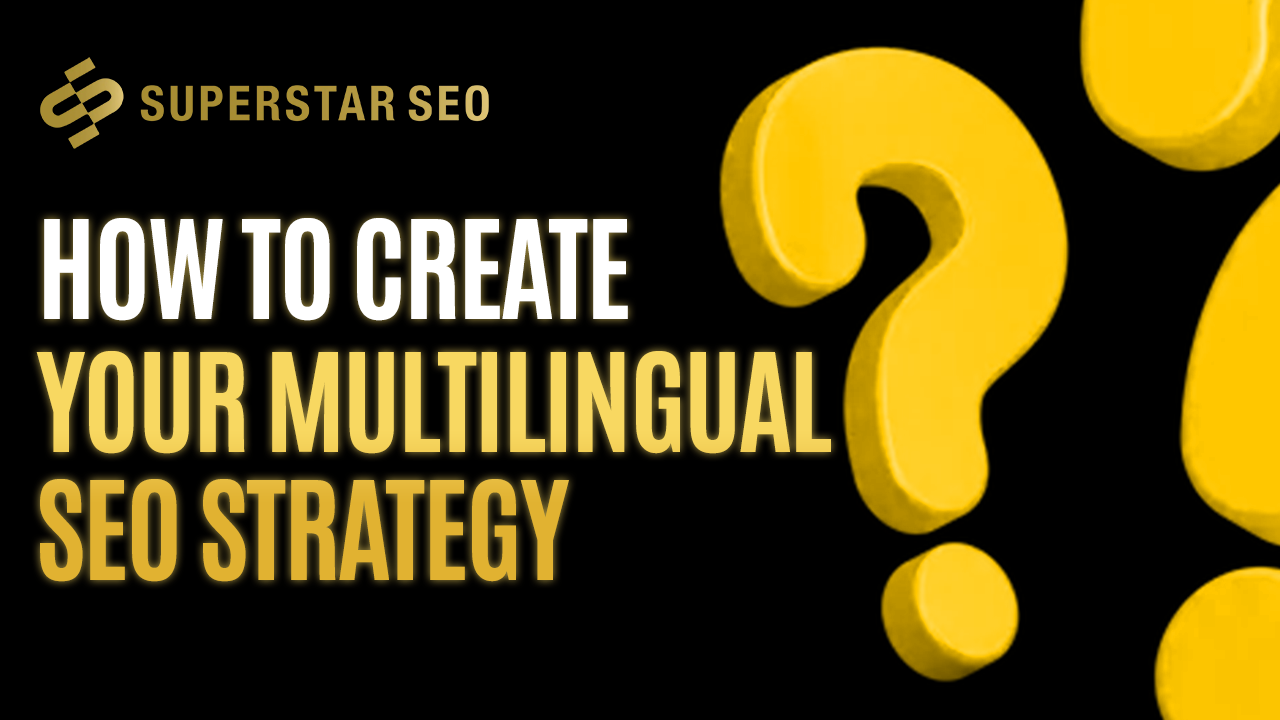How to Create Your Multilingual SEO Strategy
In today's interconnected world, having a multilingual SEO strategy is more than a luxury; it's a necessity for businesses aiming to reach global markets. That's why you should consider hiring the Best SEO Company in Montreal.
This comprehensive guide will walk you through the essential steps to create an effective multilingual SEO strategy, ensuring your business resonates with audiences regardless of their language.
Understanding the Need for Multilingual SEO
Multilingual SEO is essential for businesses aiming to establish a global presence in today's interconnected digital landscape. This strategy extends beyond basic translation, involving the optimization of content for various languages and regions. It's a crucial step for companies looking to cater to international audiences, significantly enhancing visibility and accessibility across different search engines. While tools like Google Translate can be helpful for basic translation ns, it's essential to invest in professional translation services for accurate and culturally appropriate content.
The core of multilingual website SEO lies in its ability to resonate with users in their native language, fostering a more personalized and engaging user experience. This approach not only broadens the reach of a business but also strengthens its brand credibility and trustworthiness in international markets.
In an era where online users prefer content in their native language, multilingual SEO bridges the gap between businesses and their potential customers, making it an indispensable tool for global market penetration.
Moreover, multilingual SEO is about understanding and adapting to the unique cultural and linguistic nuances of each target market. Keywords and content strategies that are effective in one language or region might not translate directly to another.
This calls for a nuanced approach to keyword research, content creation, and marketing tactics, ensuring that they are culturally relevant and resonate with local audiences.

Analyzing Your Target Audience
Analyzing your target audience is a critical step in developing an effective multilingual site SEO strategy. It involves a deep understanding of who your potential customers are, what languages they speak, and how they interact with online content. This process is fundamental for businesses looking to tailor their online presence to suit the preferences and behaviors of different cultural and linguistic groups.
The first task is to identify the primary languages and regions of your audience. This goes beyond merely translating content into popular languages; it requires a nuanced understanding of regional dialects, cultural references, and local search trends.
Tools like Google Analytics can provide valuable insights into the geographic and linguistic distribution of your website visitors, helping to pinpoint which languages and markets to focus on.
Understanding cultural nuances and search behavior is equally important. Different regions have unique online habits, preferences, and expectations. What appeals to an audience in one country might not resonate in another. This understanding helps in crafting SEO and content strategies that are not only linguistically accurate but also culturally relevant.
Furthermore, engaging with local trends and discussions can provide insights into the specific needs and interests of your target audience in each region. Social media listening tools and local online forums can be invaluable in gaining a deeper understanding of what drives engagement in different markets.
Technical Aspects of Multilingual SEO
The technical aspects of multilingual SEO are pivotal in ensuring your website is properly optimized for different languages and regions. Following multilingual SEO best practices is essential for maximizing your website's visibility and impact across global markets.
Firstly, the structure of your multi language website plays a significant role. Choosing the right URL structure, whether it's utilizing subdomains or subdirectories for language versions, significantly impacts your multilingual SEO performance. Subdomains (like fr.example.com for French) are often used to target specific countries or regions, while subdirectories (like example.com/fr) can be effective for language targeting. This choice impacts how search engines index your site and can influence your global SEO performance.
The implementation of hreflang tags is another crucial technical element. These tags inform search engines about the language and geographical targeting of a webpage. Properly using hreflang tags ensures that the correct language version of your site appears in Google search results, depending on the user's location and language preferences. This not only improves user experience but also helps to prevent issues of duplicate content across different language versions.
For the best results, consider partnering with a multilingual SEO agency to guide you through this process. Adding hreflang attributes is crucial for multi-regional websites using the same language but catering to different regions. For instance, if you have localized English websites for both the US and UK, it's essential to inform Google about the canonical version of your content to avoid penalties for duplicate content. Ensure to include hreflang attributes and markup in your sitemap to achieve this effectively.
Additionally, website translation and localization must be handled with SEO in mind. It's not just about translating content; it's about ensuring that all elements of your website, including meta tags, meta descriptions, title tags, and even image alt texts, are appropriately localized. SEO considerations should be integrated into the translation process to maintain keyword relevance and on-page optimization across languages.
These technical aspects require careful planning and execution. They form the backbone of an effective multilingual website SEO strategy, ensuring that your website is not only accessible in multiple languages but also optimized for search engines in each of those languages. Proper implementation leads to better visibility, more accurate targeting, and an overall stronger presence in international markets.
Keyword Research in Multiple Languages
Conducting keyword research in multiple languages is a critical component of a multilingual SEO strategy. It's not just about translating existing keywords from one language to another; it requires an in-depth understanding of the search habits, preferences, and language nuances in each target market.
Each language and region has its own set of popular search terms and user intent. A direct translation of keywords can often miss the mark, failing to capture how people naturally search in different languages.
For example, colloquial terms and regional variations in language can significantly impact search behavior. Therefore, keyword research for multilingual SEO must be carried out independently for each language, taking into account local search terms and phrases.
Keyword research tools like Google Keyword Planner, SEMrush, and Ahrefs offer capabilities for researching keywords in different languages. Utilizing these tools, SEO professionals can uncover the specific keywords and phrases that are most relevant and popular among the target audience in each region. This research helps identify the terms that are likely to drive traffic and conversions.
Moreover, understanding local search intent is crucial. Keywords may have different connotations or be used in different contexts in various languages. It's important to understand not just what people are searching for but why they are searching for it. This insight helps in creating content that meets the needs and expectations of the local audience.

Content Creation and Localization
Content creation and localization are vital components of a multilingual SEO strategy, requiring more than direct translation. This process involves adapting content to suit the cultural context and preferences of each target market. Localization includes adjusting not just the text but also other elements, like images and videos, to ensure cultural relevance and appropriateness.
Engaging native speakers for content creation is crucial. They bring insights into local slang, humor, and cultural nuances, ensuring that the content resonates naturally with the audience. Additionally, this localized content needs to be SEO-optimized, incorporating relevant local keywords and search terms to enhance discoverability in each region. Choosing the right content language is crucial for ensuring that your website ranks well in international searches and resonates with target audiences worldwide.
In essence, effective content creation and localization in a multilingual SEO strategy means crafting content that is not only linguistically accurate but also culturally attuned and optimized for search engines. This approach ensures that the content is engaging, relevant, and accessible to a diverse global audience. User-generated content can play a crucial role in connecting with international audiences, fostering authenticity and trust across different language communities.
Link Building and Local SEO Strategies
Link building and local SEO strategies are crucial elements of a successful multilingual SEO campaign. They involve creating a strong backlink profile for each language version of your site and employing localized SEO tactics to enhance visibility in specific regions.
In multilingual Search Engine Optimization, it's important to build a diverse range of backlinks for different language versions of your website. This involves not just translating existing content but creating unique, high-quality content that appeals to each target audience. Engaging with local influencers, bloggers, and industry websites can help garner valuable backlinks and increase your site's authority in specific regions.
Local SEO tactics are also key. This includes optimizing your website for local search terms, ensuring your business is listed in local directories, and leveraging local social media platforms. It's about making your site more visible and relevant to users in specific geographic areas.
Monitoring and Optimizing Your Multilingual SEO Efforts
Monitoring and optimizing your multilingual SEO efforts is an ongoing process that ensures the effectiveness of your international SEO strategy. It involves regularly tracking the performance of your multilingual websites across different languages and regions and making data-driven adjustments to improve outcomes.
Key to this process is the use of analytics tools like Google Analytics and Google Search Console. These platforms provide insights into how your website performs in various markets, including website traffic sources, user behavior, and organic search rankings. By analyzing this data, you can identify which aspects of your multilingual sites SEO strategy are working well and which areas need improvement.
Regular monitoring allows for quickly identifying issues like poor performance in a particular language or region. This enables timely adjustments, whether it's tweaking your keyword strategy, refining your content, or addressing technical SEO problems.
Conclusion
Creating a multilingual SEO strategy is a journey that involves understanding your global audience, mastering technical SEO elements, and creating culturally relevant content.
By following these steps shared by the best SEO Company in Montreal, businesses can effectively reach and engage with a diverse, global audience, unlocking new markets and growth opportunities.
Start implementing these strategies today and watch your business thrive in the global digital landscape.





